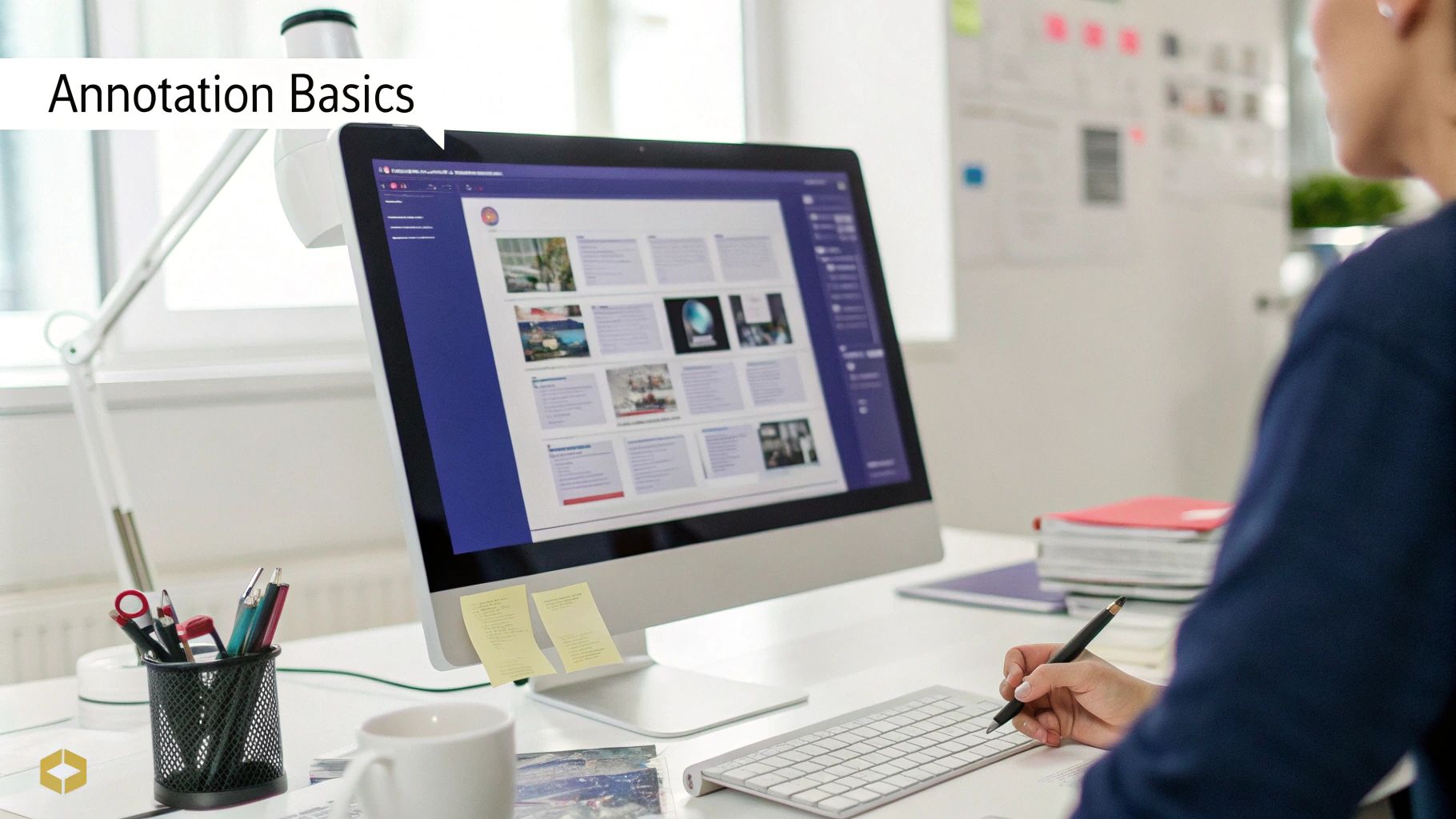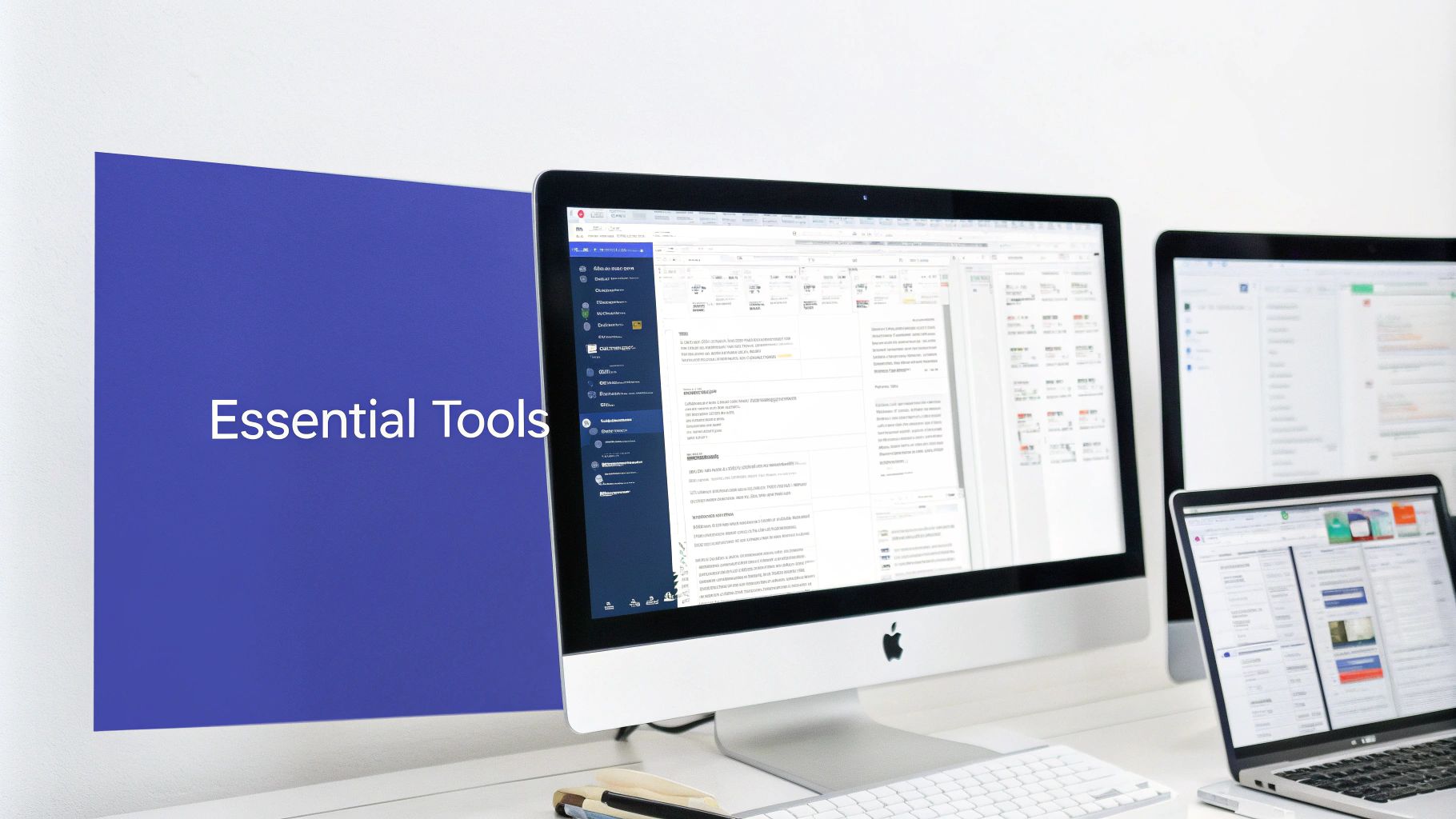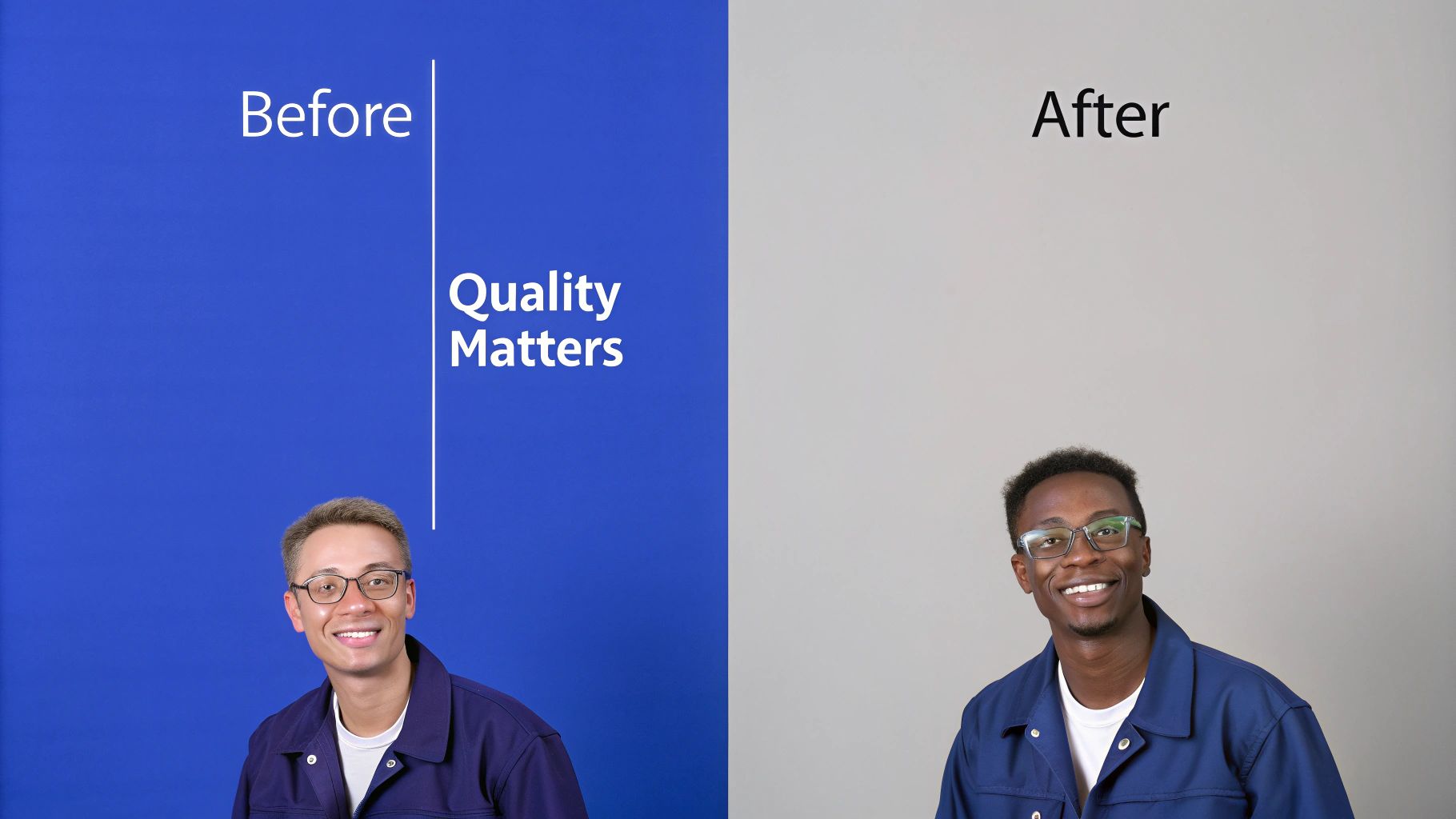Introduction to Image Annotation

Image annotation is the process of adding informative labels to images, giving context to machine learning models. This essentially teaches computers to "see" the world. Just as we teach children to identify objects by naming them, AI models learn from labeled examples, recognizing patterns and objects within images. This process is fundamental to computer vision, enabling machines to interpret visual information. As a result, we see a range of applications emerge, from self-driving cars identifying pedestrians to medical software detecting diseases.
The Crucial Role of Image Annotation
The quality of image annotation directly impacts the performance of AI models. High-quality, consistent, and detailed annotations allow models to extract accurate insights. For instance, in autonomous vehicles, precise annotation of road signs and lane markings is essential for safe navigation. In contrast, poor annotations can lead to misinterpretations by the model, potentially resulting in subpar performance or safety hazards. This highlights that effective image annotation is not simply about labeling; it's about labeling with accuracy and intention. Understanding the different methods of annotation is the next crucial step in this process.
Exploring Different Image Annotation Types
Various image annotation methods exist, each tailored to specific applications. Some common types include:
- Bounding Boxes: These boxes are drawn around objects to quickly identify location within an image, often used for object detection tasks.
- Polygon Segmentation: When object shapes are more intricate, polygons provide a precise outline, leading to more accurate identification.
- Semantic Segmentation: This method labels every single pixel with a class, creating a detailed scene map.
- Keypoint Annotation: Identifying specific points on an object, like facial features or body joints, allows for pose estimation and similar tasks.
Choosing the right method is critical. Using bounding boxes for a task requiring semantic segmentation, for instance, will likely yield poor results. The method, therefore, must align with the task complexity and desired outcome. Furthermore, the sheer volume of annotated data required for training a robust model, often thousands of images, leads us to the next important consideration: the tools and software that make this process efficient.
Tools and Software for Image Annotation
The right tools are crucial for accuracy and efficiency in image annotation. Just as a craftsman needs specific tools, developers require specialized software to perform precise and efficient annotation. The chosen software should support the required annotation type (bounding boxes, polygons, etc.) and offer features to optimize workflow. Several popular tools and software solutions are available, each varying in complexity, cost, and functionality.

Open-Source Annotation Tools
Open-source tools offer a practical starting point for smaller projects or budget-conscious developers. These tools provide basic annotation capabilities, enabling manual labeling and export in standard formats. While they might lack the advanced features of paid solutions, they offer a valuable entry point.
- LabelImg: This user-friendly tool excels at creating bounding box annotations, making it ideal for smaller projects or beginners. It enables quick labeling and export in common formats, perfect for training object detection models. However, it may be limited for complex annotation tasks.
- CVAT (Computer Vision Annotation Tool): CVAT provides a more comprehensive platform, supporting various annotation types, including bounding boxes, polygons, and semantic segmentation. Its web-based interface allows for team collaboration, but setup and maintenance may require some technical proficiency.
The choice between these open-source tools depends heavily on the project's needs. LabelImg suffices for basic bounding box annotation, while CVAT caters to projects needing diverse annotation and collaborative workflows.
Commercial Annotation Platforms
Commercial platforms offer a more robust feature set and dedicated support, suitable for larger, more complex projects. They frequently include automation and quality control mechanisms, enhancing efficiency and precision.
- BugSmash: This versatile platform streamlines feedback and annotation across different media, including images. It simplifies annotation, comment sharing, and collaborative review. With its focus on secure data handling and fast processing, BugSmash is particularly well-suited for projects with sensitive data and large datasets. It effectively consolidates feedback in one location, removing the need for scattered email chains.
- V7 Darwin: Focusing on automating image annotation workflows, V7 Darwin features tools like auto-annotation and active learning, significantly reducing manual effort. Its sophisticated dataset management capabilities aid in organization and version control. However, its advanced features come at a premium price, making it a better fit for well-funded projects.
Selecting between open-source and commercial options requires balancing cost and features with project requirements. While open-source tools can be sufficient for smaller projects, the advanced features and support offered by commercial platforms like BugSmash and V7 Darwin are invaluable for larger-scale, complex projects requiring meticulous annotation and efficient workflow.
Best Practices in Image Annotation
Choosing the right tools is just the first step. Effective image annotation relies on adhering to best practices to ensure accuracy and consistency, maximizing the data's effectiveness in training AI models. This involves careful consideration of several factors throughout the annotation process.
Maintaining Clarity and Consistency
Clarity and consistency are fundamental. Just as following a recipe ensures a consistent outcome, consistent annotation leads to predictable results. Each annotation should clearly and accurately represent the object or feature it labels. For example, all cars should be labeled "car," regardless of their specific attributes. This allows the model to learn the defining characteristics of a car without being confused by irrelevant details. This consistency must apply to all images for a cohesive and effective dataset.
Accuracy: The Foundation of Effective Annotation
Accuracy is paramount. Inaccurate labels will mislead the model, leading to poor performance and unreliable predictions. Mislabeling a pedestrian as a bicycle, for example, can have dire consequences in a self-driving car model. Therefore, each annotation requires careful review for precision. This meticulous approach minimizes errors and ensures data integrity.
Navigating Ambiguity and Edge Cases
Ambiguity presents a particular challenge. What happens when an object is partially obscured or difficult to categorize? These situations require consistent application of predefined rules. For instance, if a car is partially hidden, annotators should still draw a bounding box around the entire car. This consistent approach helps the model learn to recognize objects even in less-than-ideal conditions. Establishing guidelines for these scenarios ensures consistency across all annotators and prevents discrepancies in the data.
Choosing the Right Annotation Type for the Task
Choosing the appropriate annotation type is essential. Different annotation types serve different purposes. Bounding boxes are suitable for object detection, while semantic segmentation is necessary for pixel-level classification. Using the wrong type leads to suboptimal results. Therefore, selecting the correct annotation type is essential for project success. Check out our guide on How to master PDF annotations.
The Importance of Tool Proficiency
Proficiency with the chosen annotation tools contributes significantly to speed and accuracy. Just as a skilled craftsman works efficiently with their tools, familiarity with annotation software allows for faster and more precise work. This minimizes errors and ensures consistent application of best practices. Moreover, leveraging advanced software features like automated labeling or quality control functionalities further optimizes the workflow.
Quality Control Methods in Image Annotation

Ensuring annotation accuracy and consistency is paramount for reliable AI models. Just as a building's foundation determines its stability, the quality of your annotations dictates the effectiveness of your AI project. Implementing rigorous quality control methods is therefore essential.
Consensus-Based Annotation
Consensus-based annotation, where multiple annotators label the same image independently, is a powerful technique. Comparing these independent annotations highlights discrepancies and helps establish a "ground truth" label. This process helps mitigate individual biases and improves overall accuracy.
Regular Audits for Consistent Quality
Regular audits are essential for maintaining data quality. These involve reviewing a random sample of annotated images to assess consistency and identify potential errors. This practice allows for timely intervention and corrective action, such as retraining on specific object classes.
Clear Annotation Guidelines
Clearly defined guidelines are the foundation of any successful quality control system. These guidelines should provide explicit criteria for each annotation type, including examples of correct and incorrect labeling. This ensures all annotators follow the same standards, reducing ambiguity and promoting consistency.
Feedback Mechanisms for Continuous Improvement
Establishing feedback mechanisms promotes continuous improvement. Providing annotators with regular feedback, both positive and constructive, helps improve individual performance and identifies systemic issues. Creating avenues for annotators to ask questions and provide feedback on the guidelines themselves fosters a collaborative environment and enhances data quality. You might be interested in: Effective Feedback Loops Guide.
Time Management in Image Annotation
Best practices and quality control are vital, but efficient time management is equally crucial for project success. This involves strategic planning and the implementation of techniques to optimize the annotation workflow.
Planning Your Annotation Workflow
A well-defined plan is essential. Before beginning annotation, analyze project requirements, dataset size, and the chosen annotation type. This includes defining clear objectives, establishing a consistent labeling scheme, and developing a project timeline. These initial steps ensure a streamlined workflow and contribute significantly to efficiency.
Breaking Down the Task
Large annotation projects can be daunting. Breaking them into smaller, manageable tasks based on object categories or image types makes the project less overwhelming and allows for more focused effort, improving both speed and accuracy.
Utilizing Tools and Shortcuts
Proficiency with annotation tools is key for efficient time management. Explore keyboard shortcuts, automation features, and other functionalities that can streamline the workflow. Leveraging these features can drastically reduce annotation time and increase productivity.
Regular Breaks and Rest
While seemingly counterintuitive, regular breaks are crucial for maintaining productivity. Extended periods of focused work lead to fatigue and decreased accuracy. Scheduling short breaks throughout annotation sessions helps maintain focus and ensures high-quality work.
Team Collaboration in Image Annotation

Effective image annotation often involves coordinating the efforts of multiple annotators. This requires careful management to ensure consistency, maximize efficiency, and achieve a high-quality annotated dataset.
Clear Communication Channels
Establishing clear communication channels is essential. Designating specific platforms for different types of communication, such as project updates via email and quick questions via instant messaging, prevents information overload and ensures important messages are not missed. Clear communication protocols further streamline communication and improve efficiency.
Developing Shared Understanding
Developing a shared understanding of the annotation task and standards is crucial. This involves creating comprehensive guidelines that detail every aspect of the process, from object definitions and labeling conventions to handling edge cases. This shared understanding minimizes discrepancies and improves data quality.
Conflict Resolution and Feedback Mechanisms
A defined conflict resolution process is essential for addressing disagreements and reaching consensus. This might involve escalating issues to a senior annotator or employing a consensus-based approach for disputed images. Regular feedback mechanisms, including peer reviews or manager feedback, ensure ongoing quality control and continuous improvement.
Project Management Tools
Utilizing project management tools enhances team coordination and progress tracking. These tools provide centralized platforms for task assignment, deadline management, and progress visualization. Many tools also offer collaborative review and feedback features, streamlining quality control and promoting team cohesion.
Conclusion
Image annotation is a multifaceted process crucial to computer vision. From selecting the right tools and techniques to implementing quality control and fostering team collaboration, each aspect is vital for a successful AI project. Efficient time management and consistent adherence to best practices lead to high-quality datasets, enabling AI models to perform optimally.
Key Takeaways for Effective Image Annotation
- Clarity and Consistency: Maintain clear and consistent standards throughout the project.
- Accuracy is Paramount: Precise and carefully reviewed annotations are essential.
- Choosing the Right Tools: Select tools and software appropriate for the project's needs.
- Teamwork is Key: Effective collaboration through clear communication and shared understanding is vital.
By following these image annotation tips, you create high-quality datasets that unlock the full potential of your AI models. This contributes to innovation and advancements in computer vision. Ready to improve your workflow and team collaboration? Try BugSmash for a simplified feedback and annotation process.